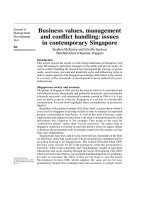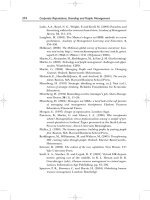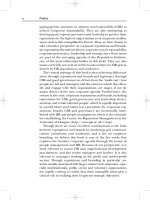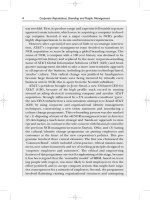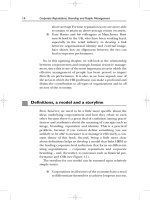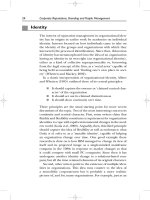Tài liệu Business values, management and conflict handling: issues in contemporary Singapore ppt
Bạn đang xem bản rút gọn của tài liệu. Xem và tải ngay bản đầy đủ của tài liệu tại đây (79.14 KB, 17 trang )
Journal of
Management
Development
14,4
56
Business values, management
and conflict handling: issues
in contemporary Singapore
Stephen McKenna and Julia Richardson
Stansfield School of Business, Singapore
Introduction
This article reports the results of work being undertaken in Singapore with
some 300 managers and future managers in the public and private sector. As
well as conflict handling the research has investigated the concepts of power,
needs, assertiveness, personal and leadership styles and influencing styles in
order to paint a picture of the Singaporean manager of the future in the context
of a society at the crossroads of development from an industrial to post-
industrial one.
Singaporean society and economy
The picture of Singapore often seen by the outside world is of a structured and
well-ordered society, theoretically and politically democratic and economically
extremely successful, with anticipated economic growth in 1994 of 6 to 8 per
cent. In many respects, however, Singapore is a society of considerable
contradiction. A recent book highlights these contradictions in persuasive
detail[1].
Regardless of the political context of Dr Chee’s book a crucial theme within it
is the need for Singapore to develop socially in order to maintain its important
position economically in Asia-Pacific. As well as this need to become a more
sophisticated and cultured society, there is the need to develop the psyche of the
individuals who comprise it. For example, Chee points to the need for
“contentious debate” rather than “forced consensus”. He argues that in
Singapore contention is frowned on and cites politics where, he argues, debate
is absent as the government seeks to maintain control over the country, as it has
done since independence.
Singaporeans have been, and to some extent still are, dependent on the State
for their basic safety and social needs. The government has committed itself to
providing housing to all Singaporeans. The Central Provident Fund (CPF)
provides some security for all of the population, while the government is
extremely visible in the community and “matchmaking” couples of equivalent
educational and social standing through the Social Development Unit (SDU)
which can best be described as a government matchmaking body for graduates.
In order to maximize the effect of this service there is also the Social
Development Section (SDS) which supplies the same service for non-
graduates[2]. Despite this seemingly universal assistance, to a larger extent,
Journal of Management
Development, Vol. 14 No. 4, 1995,
pp. 56-70. © MCB University Press,
0262-1711
Business values,
management
and conflict
57
higher level needs (self-esteem, actualization) are ignored. There is a
materialistic ambiance about Singapore which is simultaneously promoted yet
held in disdain by the government, and reflects deeper uncertainty about the
clash of traditional and modern values.
It would be wrong, however, to believe that, while in the opinion of some
debate is societally restricted, individuals within Singaporean society feel that
such consensus is positive. Furthermore, they may have different inclinations
towards conflict or contentious situations. In other words, the approach towards
handling conflict in the organizational world will reflect the individuals and
power structures within organizations as well as the societal context in which
those organizations operate. Consequently, it is possible that, while the
government promotes consensus or compromise, individuals may reject it.
The organizational context
The economy in Singapore is dominated by two types of business organization:
the multinational corporation (MNC), of which there are some 7,000 in
Singapore, and the government-linked companies (GLC). This organizational
infrastructure may have some important consequences for the organizational
experience of most individuals; in short, it is likely to be bureaucratic. This is
important because of the manner in which bureaucratic structures typically
operate; creating conformity to rules and regulations, policies and procedures
leading to rigidity and inflexibility; employee alienation; concentration of power
and external user frustration. Employee alienation and strict adherence to roles
often mean avoiding conflict by resorting to intransigence[3,4].
It might be suggested, then, that for the majority of Singaporeans work in
such organizations may restrict, structurally, the opportunity for debate, and,
therefore, the potential for creativity and innovation. This situation may be
compounded by the nature of local management[5] and society itself which
emphasizes the maintenance of harmony or the appearance of value consensus.
It is important to note, however, that this phenomenon is not peculiar to
Singaporean society or indeed the work environment, but may be found in other
Asian countries; for example, Japanese society with its concept of tate mai –
keeping up the appearance of socially approved behaviour and consensus – and
Indonesian society with its emphasis on avoiding conflict or making others feel
malu (shame/anger), and the concept of mai pen rai in Thailand, the desire to
keep things on an even keel. In terms of organizational and economic activity,
then, the following data may also be relevant outside of Singaporean society.
How are Singaporeans, particularly young future managers, inclined in
handling conflict? We might expect, if we are to believe the prevailing
stereotypes of Asians, that they seek to avoid all open conflict. The rest of this
article outlines some of the prevailing Western thinking on conflict resolution
and the results of the Singapore survey on handling conflict. Finally it makes
some comments about the implications for management and organizations in a
changing global and regional economic and social environment.
Journal of
Management
Development
14,4
58
Conflict resolution strategies
Many societies and organizations attempt to promote the notion, far beyond
what reality tells us, that harmony and consensus are both prevalent and
positive. Cursory experience of societies and organizations indicates that this is
a myth and that conflict is, in fact, the reality that all human beings experience
in their day-to-day lives. Most of this conflict is dealt with easily, but in some
situations it is of considerable importance and not so easy to resolve. Thus a
strategy for resolution is essential.
In management, the ability to resolve conflicts successfully is a vital skill
which has two subskills: the cognitive (do I understand how conflict can be
resolved?), and the behavioural (can I resolve specific conflicts?). It is vital that
the manager understands how he/she resolves conflict him/herself. There are a
number of approaches to discovering this, but many have elements in common
[6-9].
In a general sense there is the manner in which individuals deal with conflict
situations as identified by Cornelius and Faire[10]. These authors identify five
possible reactions to circumstances of conflict:
(1) Withdrawal: the individual responds to conflict by ceasing to talk,
sulking, retiring hurt, becoming resentful, becoming depressed, saying
nasty things behind another’s back, stopping caring about anybody,
moving to a business only level.
(2) Suppression: here the individual deals with conflict as if nothing is
wrong, carries on regardless, puts up with a difficult conflict situation for
the sake of peace, uses charm to get his or her own way, says nothing at
the time but is devious later on, keeps all bad feelings inside.
(3) Compromise: an individual who compromises in dealing with conflict
attempts to maintain the friendship, tries to discover what is fair, divides
the prize equally, avoids pulling rank or being authoritarian, gives
something to preserve the relationship.
(4) Win/lose: a person who seeks to win in conflict and not lose will set out
to show that the other person is wrong, get moody and sulk until they
change their mind, shout them down, turn physically violent, refuse to
take “no” for an answer.
(5) Win/win: the individual who seeks win/win solutions to conflict will find
out what others need, find out where differences come together, design
new options where people get more of what they need and work in
partnership with others to find solutions.
The Thomas-Kilmann approach
A well-known and widely-used approach to understanding the different ways in
which people deal with conflict is the Thomas-Kilmann conflict mode
instrument[11]. Unlike the work of Cornelius and Faire[12], Thomas and
Kilmann do not suggest that all conflict is best resolved by searching for a
Business values,
management
and conflict
59
win/win situation. Indeed, there are a number of different ways to deal with
conflict and each of these modes of conflict handling can be useful under
different sets of circumstances. For example, following the five conflict-
handling modes identified by Thomas and Kilmann, each of the following may
be appropriate under divergent circumstances:
●
“two heads are better than one” (collaborating);
●
“kill your enemies with kindness” (accommodating);
●
“split the difference” (compromising);
●
“leave well enough alone” (avoiding);
●
“might makes fight” (competing).
The extent to which a given conflict-handling mode is effective depends on the
requirements of the specific conflict situation and the skill with which it is used.
In this sense in any given situation a particular mode of handling conflict may
be more suitable than others. Furthermore, every individual is capable of using
all five conflict-handling modes; nobody can be characterized as having a
single, inflexible style of dealing with conflict, although some people will be
more inclined than others to use certain modes. The conflict behaviours of
individuals, therefore, are a combination of their personal characteristics and
the requirements of the circumstances within which they find themselves. This
is important and is the purpose of the Thomas-Kilmann conflict mode
instrument.
In addition to the conflict-handling modes, Thomas and Kilmann developed
their model further by indicating that all reactions to conflict stem from two
general impulses. First, assertive behaviour, the desire to satisfy personal
concerns and, second, non-assertive behaviour, the desire to satisfy the
concerns of others. Figure 1 represents the model.
Competing
(domination)
Collaborating
(integration)
Avoiding
(neglect)
Accommodating
(appeasement)
Compromising
(sharing)
Assertive
Non-assertive
Unco-operative Co-operative
Figure 1.
Modes of handling
conflict
Journal of
Management
Development
14,4
60
The Singapore survey
The survey of managers and future managers in Singapore involved 303
respondents. Some 51 per cent were male, 49 per cent female. These figures are
representative of the total population of Singapore, 50.6 per cent male and 49.3
per cent female (Census, 1992). The ethnic make-up of the group was 79 per
cent Chinese, 8 per cent Indian, 5 per cent Malay and 3 per cent Eurasian. The
figures for Chinese, Indian, Eurasian/others are representative of figures for the
Singaporean population as a whole – 77.61 per cent Chinese, 7.08 per cent
Indian and 1.2 per cent Eurasian/other. For Malays our sample of 5 per cent is
not representative of the Malay population of Singapore (14.17 per cent ) but
taking into account that all respondents were full-time or part-time students
enrolled in an institute of higher education, the under-representation of Malays
should be taken in the light of the fact that the average number of years of
formal education of Malays (7.7) is lower than that of the Chinese (8.4), Indian
(8.4) and Eurasian (8.0)[12]. It may be suggested, therefore, that Malays are less
likely to be taking part in higher education. Of the respondents 10 per cent were
in management or administration, 12 per cent in public services and 14 per cent
in private services; some 13 per cent were in production, engineering and
technology; 16 per cent were in clerical and secretarial jobs; 8 per cent were in
the armed forces and 22 per cent were full-time students. Of the respondents 97
per cent were in the age range 16 to 35, almost half in the 21 to 25 range. The
group, therefore, represented a young, upwardly mobile and ultimately well-
educated group of people who would be very important to the future of
Singapore and management in Singapore.
Gender
Figure 2 indicates the dominant modes of handling conflict. The two
predominant modes of handling conflict for both men and women were
compromising and avoiding, although the greatest tendency for men was
compromising and, for women, avoiding.
Figure 3 compares gender by the three main racial groups in Singapore.
Within the Chinese group the overall pattern is similar for men and women;
men have a greater tendency to compromise when resolving conflict, and
women have a greater tendency towards compromise, closely followed by
avoidance. In the Indian racial group men and women handled conflict
differently; men tended to be more compromising, whereas women tended
towards collaborating. Both men and women have a tendency towards
avoidance. The Malay group show that men are compromisers while women are
very clearly avoiders.
We would expect there to be some difference in the way men and women
handle conflict in any society. Gender identity is primarily a social construction
and as a consequence derives from processes of learned behaviour. This
socialization process tends to promote the view that women are biologically
suited to the role of wife and mother. By comparison, men, also by virtue of their
“biogrammar” are seen to be more suited to, and capable of, achievement
Business values,
management
and conflict
61
8
7
6
5
4
3
2
1
0
Collaborating
Compromising
Avoiding
Accommodating
Competing
Key
:
Male Female
Figure 2.
Modes of handling
conflict in relation to
gender
10
9
8
7
6
5
4
3
2
1
0
Chinese
(male)
Chinese
(female)
Indian
(male)
Indian
(female)
Malay
(male)
Malay
(female)
Competing
Collaborating
Compromising
Avoiding
Accommodating
Key
:
Figure 3.
Modes of handling
conflict in relation to
race and gender

